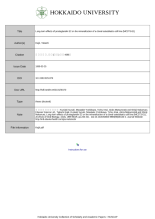Long-term effects of prostaglandin E2 on the mineralization of a clonal osteoblastic cell line (MC3T3-E1) 骨芽細胞様細胞株(MC3T3-E1)の石灰化に対するプロスタグランジンE2長期投与の効果
この論文にアクセスする
この論文をさがす
著者
書誌事項
- タイトル
-
Long-term effects of prostaglandin E2 on the mineralization of a clonal osteoblastic cell line (MC3T3-E1)
- タイトル別名
-
骨芽細胞様細胞株(MC3T3-E1)の石灰化に対するプロスタグランジンE2長期投与の効果
- 著者名
-
梶井, 貴史
- 著者別名
-
カジイ, タカシ
- 学位授与大学
-
北海道大学
- 取得学位
-
博士(歯学)
- 学位授与番号
-
甲第4696号
- 学位授与年月日
-
1999-03-25
注記・抄録
博士論文
共著者あり。共著者名: Kuniaki Suzuki, Masatake Yoshikawa, Tohru Imai, Akira Matsumotob and Shinji Nakamura. Elsevier Science Ltd., Takashi Kajii, Kuniaki Suzuki, Masatake Yoshikawa, Tohru Imai, Akira Matsumotob and Shinji Nakamura, Long-term effects of prostaglandin E2 on the mineralization of a clonal osteoblastic cell line (MC3T3-E1), Archives of Oral Biology, 44(3), 1999 MAR, pp.233-241. doi:10.1016/S0003-9969(98)00120-4. Journal Website: http://intl.elsevierhealth.com/journals/arob/
Prostaglandin (PG) E2 is thought to be a mediator of the effect of mechanical stress on bone formation, but its effects on osteoblasts have not yet been fully described. Here, the effects of the continuous application of PGE2 and indomethacin, an inhibitor of prostaglandin G/H synthase (cyclo-oxygenase), on the proliferation, differentiation and mineralization of a clonal osteoblastic cell line, MC3T3-E1, were investigated. The cells were cultured in media with either a high (1 μg/ml) or a low (1 ng/ml) concentration of PGE2, with indomethacin (1 μg/ml) and, as a control, with neither agent. The effects of PGE2 and indomethacin were assessed quantitatively. Indomethacin and a high concentration of PGE2 increased the total protein compared to the control and low-PGE2 cultures. 7 days after confluence, alkaline phosphatase (ALP) activity within the cells and extracellular matrices increased. This increase was highest with indomethacin and lowest with a high concentration of PGE2. ALP activity also increased in the medium, but only 21 days after confluence; the effects of the agents were similar to those on the cells and matrices. The accumulation of calcium, inorganic phosphate and hydroxyproline was highest with indomethacin. PGE2 production was at its maximum when the cells were at confluence and was inhibited by indomethacin. Specific [3H]PGE2 binding to the microsomal fraction of the cell was also measured to examine the expression of the PGE2 receptor. The amount of [3H]PGE2 binding per mg of protein was highest at confluence, then decreased and again increased in the mineralizing stage. These results suggest that indomethacin increases ALP activity and the accumulation of mineralized tissue in MC3T3-E1 cells, presumably by inhibiting the production of PGE2. PGE2 could signal the suppression of mineralization as early as confluence.
